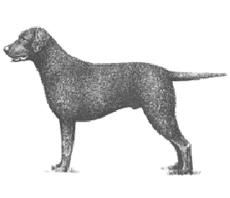Curly Coated Retriever
General Information - Curly Coated Retriever

Group:
Gundog
Size:
large
Lifespan:
8-12 years
Exercise:
medium
Grooming:
low
Trainability:
medium
Watchdog ability:
high
Protection ability:
low
Area of Origin:
England
Date of Origin:
1700s
Other Names:
none
Original Function:
water retrieving
History
The Curly-Coated Retriever is considered to be one of the oldest retriever breeds. It has been used for retrieving as long ago as the late eighteenth century in England, where it was developed. The breed probably resulted from crosses with the Close-Curled English Water Dog, the Old Water Spaniel and the St. John's Newfoundland dog. Some sources suggest the Irish Water Spaniel, the Labrador, and the Poodle. In any case, the Curly is a fine water retriever with a gentle mouth, particularly ideal for duck and quail. He is an excellent hunting companion and Gundog, and his gentle temperament also makes him an outstanding family companion.
Here in New Zealand, Curlies were established before the 1900's. Our isolation and own limitless hunting opportunities further honing their working skills. Kept primarily as a highly valued hunting dog, over the years only a small minority have been in the competitive arena. Since virtually the inception of field trials in this country, Curlies have experienced a marked degree of success, taking out various Island and National Titles, as well as individual Field Trial and Grand Field Trial Championship awards. Now, they are beginning to make their mark in other disciplines such as search and rescue (dual operational status), agility etc. They have also acquitted themselves well in the show ring, winning numerous group awards and gaining the distinction of a smattering of In-Show awards.
Temperament
The Curly-Coated Retriever is easy to get along with, loyal and eager to please. This breed is not for everyone; they need early, gentle, but firm obedience training. They can do well in competitive obedience and agility but are not as predictable a performer as a Golden Retriever. They like to do things their own way. The Curly-Coated Retriever is affectionate, loving, and excellent with children; however, they may accidentally knock over a toddler. Socialise them well with people and other pets at an early age, as this breed tends to be reserved and even timid with strangers if not properly socialised. It is a good watchdog that will also protect the family if danger threatens. This breed loves to swim. They also make good therapy dogs. Curly-Coated Retrievers make an ideal partner for an active, outdoor-oriented person who also wants a loyal family companion. This breed does not fully mature until it is about three years old.
Upkeep
The Curly is an easy dog to maintain, requiring no unusual care. It needs daily exercise, preferably involving swimming and retrieving. It can live outdoors in temperate weather, but it does best as an indoor – outdoor dog. Because brushing diminishes the tight curls, it should be combed only occasionally, preferably before getting wet. Some very minimal scissoring may be desirable to tidy up scraggly hairs. It does need regular brushing during its shedding seasons.
Curly Coated Retriever
A breed standard is the guideline which describes the ideal characteristics, temperament, and appearance of a breed and ensures that the breed is fit for function with soundness essential. Breeders and judges should at all times be careful to avoid obvious conditions and exaggerations, as well as being mindful of features which could be detrimental in any way to the health, welfare or soundness of this breed.
Breed Standard - Curly Coated Retriever
 General Appearance:
General Appearance: A strong, smart upstanding dog showing activity, endurance and intelligence.
Head and Skull: Long, well proportioned flat skull, jaws strong and long but not inclined to snipiness. Nose black in the black-coated variety with wide nostrils, coarseness of head to be deprecated.
Eyes: Black or brown but not “gooseberry” coloured, rather large but not too prominent.
Ears: Rather small, set on low, lying close to the head and covered with short curls.
Mouth: Teeth strong and level.
Neck: Should be moderately long, free from throatiness.
Forequarters: Shoulders should be very deep, muscular and well laid back.
Hindquarters: Strong and muscular, hock low to the ground with good bend to stifle and hock.
Body: Well sprung ribs, good depth of brisket, not too long in the loin, as little tucked-up in flank as possible.
Feet: Round and compact with well-arched toes.
Tail: Moderately short, carried fairly straight and covered with curls, tapering towards the point, gay tail not desirable.
Coat: Should be one mass of crisp small curls all over. This being the main characteristic of the breed should be given great consideration when judging awards.
Colour: Black or liver.
Weight and Size: Weight 31.8 - 36.3 kg (70 - 80 lb). Height approximately 63 - 69 cm (25 - 27 in).
Faults: Wide skull, light eyes, curled tail and bad movement.
Note: Male animals should have two apparently normal testicles fully descended into the scrotum.
DNZ No 312
Copyright Dogs New Zealand
01 Jan 2002
Any departure from the foregoing points should be considered a fault and the seriousness with which the fault should be regarded should be in exact proportion to its degree and its effect upon the health and welfare of the dog and on the dog’s ability to perform its traditional work.




